MA-XRF for the Characterisation of the Painting Materials and Technique of the Entombment of Christ by Rogier van der Weyden
Abstract
:1. Introduction
2. Materials and Methods
2.1. The Entombment of Christ by Rogier van der Weyden
2.2. The INFN-CHNet MA-XRF Scanner
3. Results and Discussion
4. Conclusions
Supplementary Materials
Author Contributions
Funding
Acknowledgments
Conflicts of Interest
References
- Alfeld, M. MA-XRF for Historical Paintings: State of the Art and Perspective. Microsc. Microanal. 2020, 26, 72–75. [Google Scholar] [CrossRef]
- Galli, A.; Caccia, M.; Alberti, R.; Bonizzoni, L.; Aresi, N.; Frizzi, T.; Bombelli, L.; Gironda, M.; Martini, M. Discovering the material palette of the artist: A p-XRF stratigraphic study of the Giotto panel ‘God the Father with Angels’. X-ray Spectrom. 2017, 46, 435–441. [Google Scholar] [CrossRef]
- Alfeld, M.; Mulliez, M.; Martinez, P.; Cain, K.; Jockey, P.; Walter, P. The Eye of the Medusa: XRF Imaging Reveals Unknown Traces of Antique Polychromy. Anal. Chem. 2017, 89, 1493–1500. [Google Scholar] [CrossRef] [PubMed]
- Alfeld, M.; Pedroso, J.V.; Hommes, M.V.E.; Van der Snickt, G.; Tauber, G.; Blaas, J.; Haschke, M.; Erler, K.; Dik, J.; Janssens, K. A mobile instrument for in situ scanning macro-XRF investigation of historical paintings. J. Anal. At. Spectrom. 2013, 28, 760–767. [Google Scholar] [CrossRef]
- Romano, F.P.; Caliri, C.; Nicotra, P.; Di Martino, S.; Pappalardo, L.; Rizzo, F.; Santos, H.C. Real-time elemental imaging of large dimension paintings with a novel mobile macro X-ray fluorescence (MA-XRF) scanning technique. J. Anal. At. Spectrom. 2017, 32, 773–781. [Google Scholar] [CrossRef]
- Pouyet, E.; Barbi, N.; Chopp, H.; Healy, O.; Katsaggelos, A.; Moak, S.; Mott, R.; Vermeulen, M.; Walton, M. Development of a highly mobile and versatile large MA-XRF scanner for in situ analyses of painted work of arts. X-ray Spectrom. 2021, 50, 263–271. [Google Scholar] [CrossRef]
- Saverwyns, S.; Currie, C.; Delgado, E.L. Macro X-ray fluorescence scanning (MA-XRF) as tool in the authentication of paintings. Microchem. J. 2018, 137, 139–147. [Google Scholar] [CrossRef]
- Reiche, I.; Eveno, M.; Müller, K.; Calligaro, T.; Pichon, L.; Laval, E.; Mysak, E.; Mottin, B. New insights into the painting stratigraphy of L’Homme blessé by Gustave Courbet combining scanning macro-XRF and confocal micro-XRF. Appl. Phys. A 2016, 122, 947. [Google Scholar] [CrossRef]
- Ravaud, E.; Pichon, L.; Laval, E.; Gonzalez, V.; Eveno, M.; Calligaro, T. Development of a versatile XRF scanner for the elemental imaging of paintworks. Appl. Phys. A 2016, 122, 1–7. [Google Scholar] [CrossRef]
- Delaney, J.K.; Dooley, K.A.; Van Loon, A.; Vandivere, A. Mapping the pigment distribution of Vermeer’s Girl with a Pearl Earring. Herit. Sci. 2020, 8, 1–16. [Google Scholar] [CrossRef] [Green Version]
- Ricciardi, P.; Legrand, S.; Bertolotti, G.; Janssens, K. Macro X-ray fluorescence (MA-XRF) scanning of illuminated manuscript fragments: Potentialities and challenges. Microchem. J. 2016, 124, 785–791. [Google Scholar] [CrossRef]
- Ricciardi, P.; Mazzinghi, A.; Legnaioli, S.; Ruberto, C.; Castelli, L. The Choir Books of San Giorgio Maggiore in Venice: Results of in Depth Non-Invasive Analyses. Heritage 2019, 2, 103. [Google Scholar] [CrossRef] [Green Version]
- Clarke, M.L.; Gabrieli, F.; Rowberg, K.L.; Hare, A.; Ueda, J.; McCarthy, B.; Delaney, J.K. Imaging spectroscopies to characterize a 13th century Japanese handscroll, The Miraculous Interventions of Jizō Bosatsu. Herit. Sci. 2021, 9, 1–10. [Google Scholar] [CrossRef]
- MacLennan, D.; Llewellyn, L.; Delaney, J.K.; Dooley, K.A.; Patterson, C.S.; Szafran, Y.; Trentelman, K. Visualizing and measuring gold leaf in fourteenth- and fifteenth-century Italian gold ground paintings using scanning macro X-ray fluorescence spectroscopy: A new tool for advancing art historical research. Herit. Sci. 2019, 7, 25. [Google Scholar] [CrossRef]
- Legrand, S.; Van der Snickt, G.; Cagno, S.; Caen, J.; Janssens, K. MA-XRF imaging as a tool to characterize the 16th century heraldic stained-glass panels in Ghent Saint Bavo Cathedral. J. Cult. Herit. 2019, 40, 163–168. [Google Scholar] [CrossRef]
- Lins, S.; Manso, M.; Lins, P.; Brunetti, A.; Sodo, A.; Gigante, G.; Fabbri, A.; Branchini, P.; Tortora, L.; Ridolfi, S. Modular MA-XRF Scanner Development in the Multi-Analytical Characterisation of a 17th Century Azulejo from Portugal. Sensors 2021, 21, 1913. [Google Scholar] [CrossRef]
- Alfeld, M.; Baraldi, C.; Gamberini, M.C.; Walter, P. Investigation of the pigment use in the Tomb of the Reliefs and other tombs in the Etruscan Banditaccia Necropolis. X-ray Spectrom. 2019, 48, 262–273. [Google Scholar] [CrossRef]
- Sottili, L.; Guidorzi, L.; Mazzinghi, A.; Ruberto, C.; Castelli, L.; Czelusniak, C.; Giuntini, L.; Massi, M.; Taccetti, F.; Nervo, M.; et al. The Importance of Being Versatile: INFN-CHNet MA-XRF Scanner on Furniture at the CCR “La Venaria Reale”. Appl. Sci. 2021, 11, 1197. [Google Scholar] [CrossRef]
- INFN-CHNet. Available online: http://chnet.infn.it/en/who-we-are-2/ (accessed on 29 April 2021).
- Chiari, M.; Barone, S.; Bombini, A.; Calzolai, G.; Carraresi, L.; Castelli, L.; Czelusniak, C.; Fedi, M.E.; Gelli, N.; Giambi, F.; et al. LABEC, the INFN ion beam laboratory of nuclear techniques for environment and cultural heritage. Eur. Phys. J. Plus 2021, 136, 1–28. [Google Scholar] [CrossRef]
- Giuntini, L.; Castelli, L.; Massi, M.; Fedi, M.; Czelusniak, C.; Gelli, N.; Liccioli, L.; Giambi, F.; Ruberto, C.; Mazzinghi, A.; et al. Detectors and Cultural Heritage: The INFN-CHNet Experience. Appl. Sci. 2021, 11, 3462. [Google Scholar] [CrossRef]
- Campbell, L. Rogier van der Weyden and his Workshop. Proc. Br. Acad. 1994, 84, 1–24. [Google Scholar]
- van Suchtelen, A. A painting from Florence, in Mauritshuis infocus. Rogier van der Weyden Unvelied 2018, 2, 14–15. [Google Scholar]
- Kemperdick, S. Rogier van der Weyden’s Workshop around 1440. In Rogier van der Weyden in Context: Proceedings of Symposium XVII, Leuven, November 2009 (Underdrawing and Technology in Painting. Symposia); Campbell, L., Van Der Stock, J., Reynolds, C., Watteeuw, L., Eds.; Peeters Publishers: Paris, France; Leuven, Belgium; Walpole, MA, USA, 2012; pp. 57–77. [Google Scholar]
- Billinge, R.; Campbell, L.; Dunkerton, J.; Foister, S.; Kirby, J.; Pilc, J.; Roy, A.; Spring, M.; White, R. The materials and technique of five paintings by Rogier van der Weyden and his Workshop. Nat. Gallery Tech. Bull. 1997, 18, 68–86. [Google Scholar]
- Rogier van der Weyden Unveiled. Available online: https://www.mauritshuis.nl/en/discover/exhibitions/rogier-van-der-weyden-unveiled (accessed on 10 May 2021).
- Taccetti, F.; Castelli, L.; Czelusniak, C.; Gelli, N.; Mazzinghi, A.; Palla, L.; Ruberto, C.; Censori, C.; Giudice, A.L.; Re, A.; et al. A multipurpose X-ray fluorescence scanner developed for in situ analysis. Rend. Lince. 2019, 30, 307–322. [Google Scholar] [CrossRef]
- Ruberto, C.; Mazzinghi, A.; Massi, M.; Castelli, L.; Czelusniak, C.; Palla, L.; Gelli, N.; Betuzzi, M.; Impallaria, A.; Brancaccio, R.; et al. Imaging study of Raffaello’s “La Muta” by a portable XRF spectrometer. Microchem. J. 2016, 126, 63–69. [Google Scholar] [CrossRef]
- Mazzinghi, A.; Ruberto, C.; Castelli, L.; Ricciardi, P.; Czelusniak, C.; Giuntini, L.; Mandò, P.A.; Manetti, M.; Palla, L.; Taccetti, F. The importance of being little: MA-XRF on manuscripts on a Venetian island. X-ray Spectrom. 2021, 50, 272–278. [Google Scholar] [CrossRef]
- Vadrucci, M.; Mazzinghi, A.; Sorrentino, B.; Falzone, S.; Gioia, C.; Gioia, P.; Loreti, E.M.; Chiari, M. Characterisation of ancient Roman wall-painting fragments using non-destructive IBA and MA-XRF techniques. X-ray Spectrom. 2020, 49, 668–678. [Google Scholar] [CrossRef]
- Stols, M. Grounds. 1400–1900. In Conservation of Easel Paintings, 2nd ed.; Stoner, J.H., Rushfield, R., Eds.; Routledge Publisher: Oxfordshire, England, 2020; pp. 161–188. ISBN 9780367023799. [Google Scholar]
- de Viguerie, L.; Glanville, H.; Ducouret, G.; Jacquemot, P.; Dang, P.; Walter, P. Re-interpretation of the Old Masters’ practices through optical and rheological investigation: The presence of calcite. Comptes Rendus Phys. 2018, 19, 543–552. [Google Scholar] [CrossRef]
- Spring, M. The Materials of Rogier van der Weyden and his contemporaries in context. In Rogier van der Weyden in Context: Proceedings of Symposium XVII, Leuven, November 2009 (Underdrawing and Technology in Painting. Symposia); Campbell, L., van Der Stock, J., Reynolds, C., Watteeuw, L., Eds.; Peeters Publishers: Paris, France; Leuven, Belgium; Walpole, MA, USA, 2012; pp. 93–105. [Google Scholar]
- Smieska, L.M.; Mullett, R.; Ferri, L.; Woll, A.R. Trace elements in natural azurite pigments found in illuminated manuscript leaves investigated by synchrotron x-ray fluorescence and diffraction mapping. Appl. Phys. A 2017, 123. [Google Scholar] [CrossRef]
- Delaney, J.K.; Ricciardi, P.; Deming Glinsman, L.; Facini, M.; Thoury, M.; Palmer, M.; de la Rie, E.R. Use of imaging spectroscopy, fiber optic reflectance spectroscopy, and X-ray fluorescence to map and identify pigments in illuminated manuscripts. Stud. Conserv. 2014, 59, 91–101. [Google Scholar] [CrossRef] [Green Version]
- Aru, M.; Burgio, L.; Rumsey, M.S. Mineral impurities in azurite pigments: Artistic or natural selection? J. Raman Spectr. 2014, 45, 1013–1018. [Google Scholar] [CrossRef]
- Cennini, C. Chapter CXLVI, Come dèi fare vestiri di azzurro, d’oro, o di porpora. In Il Libro dell’Arte, o Trattato della Pittura; Milanesi, G., Milanesi, C., Eds.; Le Monnier: Firenze, Italy, 1859. [Google Scholar]
- Keune, K.; Boon, J.J. Imaging Secondary Ion Mass Spectrometry of a paint cross section taken from an Early Netherlandish painting by Rogier van der Weyden. Anal. Chem. 2004, 76, 1374–1385. [Google Scholar] [CrossRef]
- Ganio, M.; Pouyet, E.S.; Webb, S.M.; Schmidt Patterson, C.M.; Walton, M.S. From lapis lazuli to ultramarine blue: Investigating Cennino Cennini’s recipe using sulfur K-edge XANES. Pure Appl. Chem. 2018, 90, 463–475. [Google Scholar] [CrossRef]
- Gambardella, A.A.; Marine, C.; de Nolf, W.; Schnetz, K.; Erdmann, R.; van Elsas, R.; Gonzalez, V.; Wallert, A.; Iedema, P.D.; Eveno, M.; et al. Sulfur K-edge micro- and full-field XANES identify marker for preparation method of ultramarine pigment from lapis lazuli in historical paints. Sci. Adv. 2020, 6, eaay8782. [Google Scholar] [CrossRef]
- Kirby, J.; Spring, M.; Higgitt, C. The Technology of Red Lake Pigment Manufacture: Study of the Dyestuff Substrate. Natl. Gallery Tech. Bull. 2005, 26, 71–87. [Google Scholar]
- Lutzenberger, K.; Stege, H.; Tilenschi, C. A note on glass and silica in oil paintings from the 15th to the 17th century. J. Cult. Herit. 2010, 11, 365–372. [Google Scholar] [CrossRef]
- Spring, M. New insights into the materials of fifteenth- and sixteenth-century Netherlandish paintings in the National Gallery, London. Herit. Sci. 2017, 5, 40. [Google Scholar] [CrossRef] [Green Version]
- Mazzinghi, A.; Ruberto, C.; Castelli, L.; Czelusniak, C.; Taccetti, F.; Mandò, P.A. Indagini XRF a scansione sul Ritratto di papa Leone X con i cugini cardinali. In Raffaello e il Ritorno del Papa Medici: Restauri e Scoperte sul Ritratto di Leone X con i due Cardinali; Ciatti, M., Schmidt, E.D., Eds.; Edifir Edizioni Firenze: Firenze, Italy, 2020; Volume 54, pp. 219–226. [Google Scholar]
- Wedepohl, K.H.; Simon, K. The chemical composition of medieval wood ash glass from Central Europe. Geochemistry 2010, 70, 89–97. [Google Scholar] [CrossRef]
- Spring, M. Colourless Powdered Glass as an Additive in Fifteenth- and Sixteenth-Century European Paintings. Natl. Gallery Tech. Bull. 2012, 33, 4–26. [Google Scholar]
- Gettens, R.J.; Feller, R.L.; Chase, W.T. Vermilion and Cinnabar. Stud. Cons. 1972, 17, 45–69. [Google Scholar]
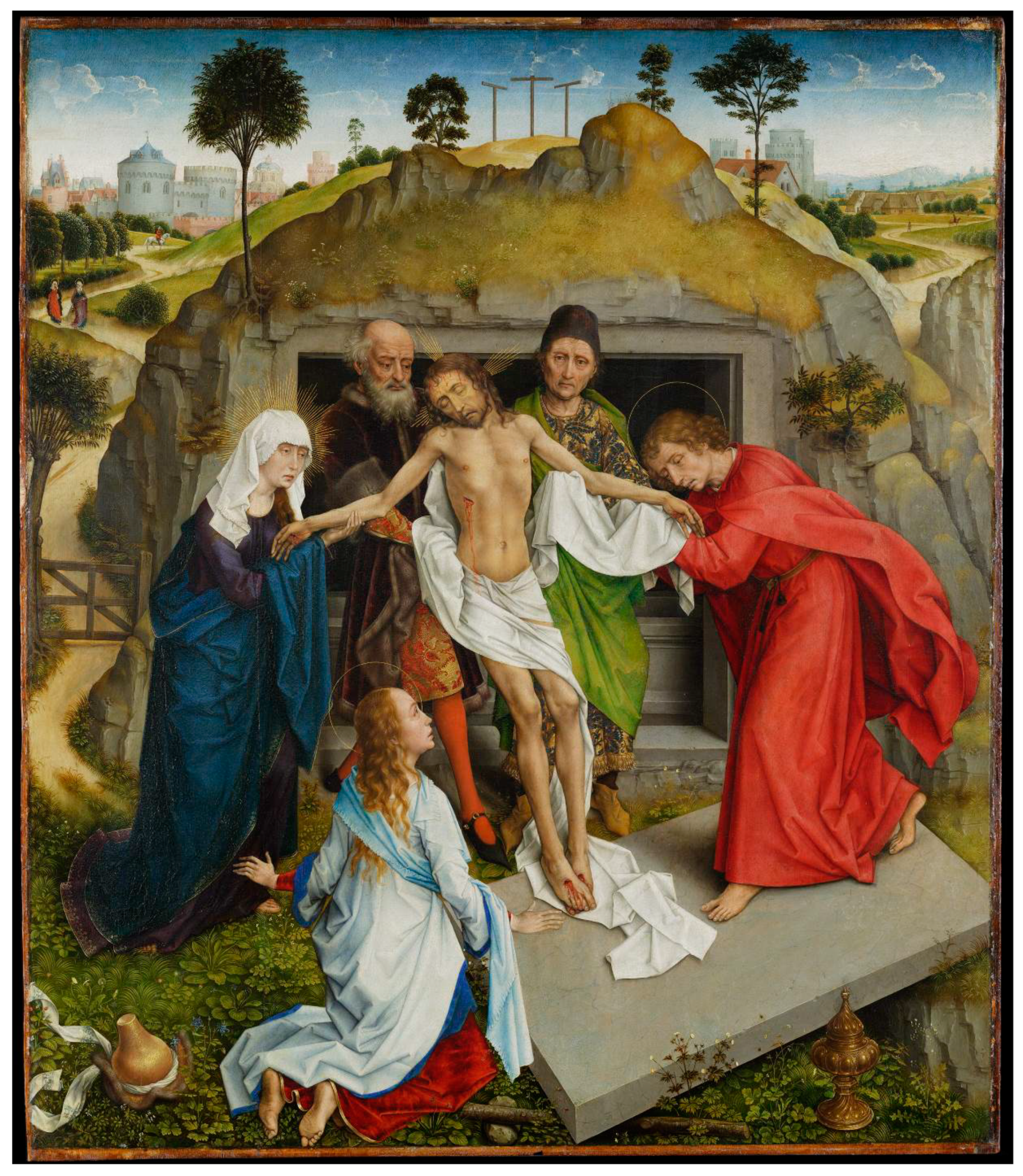
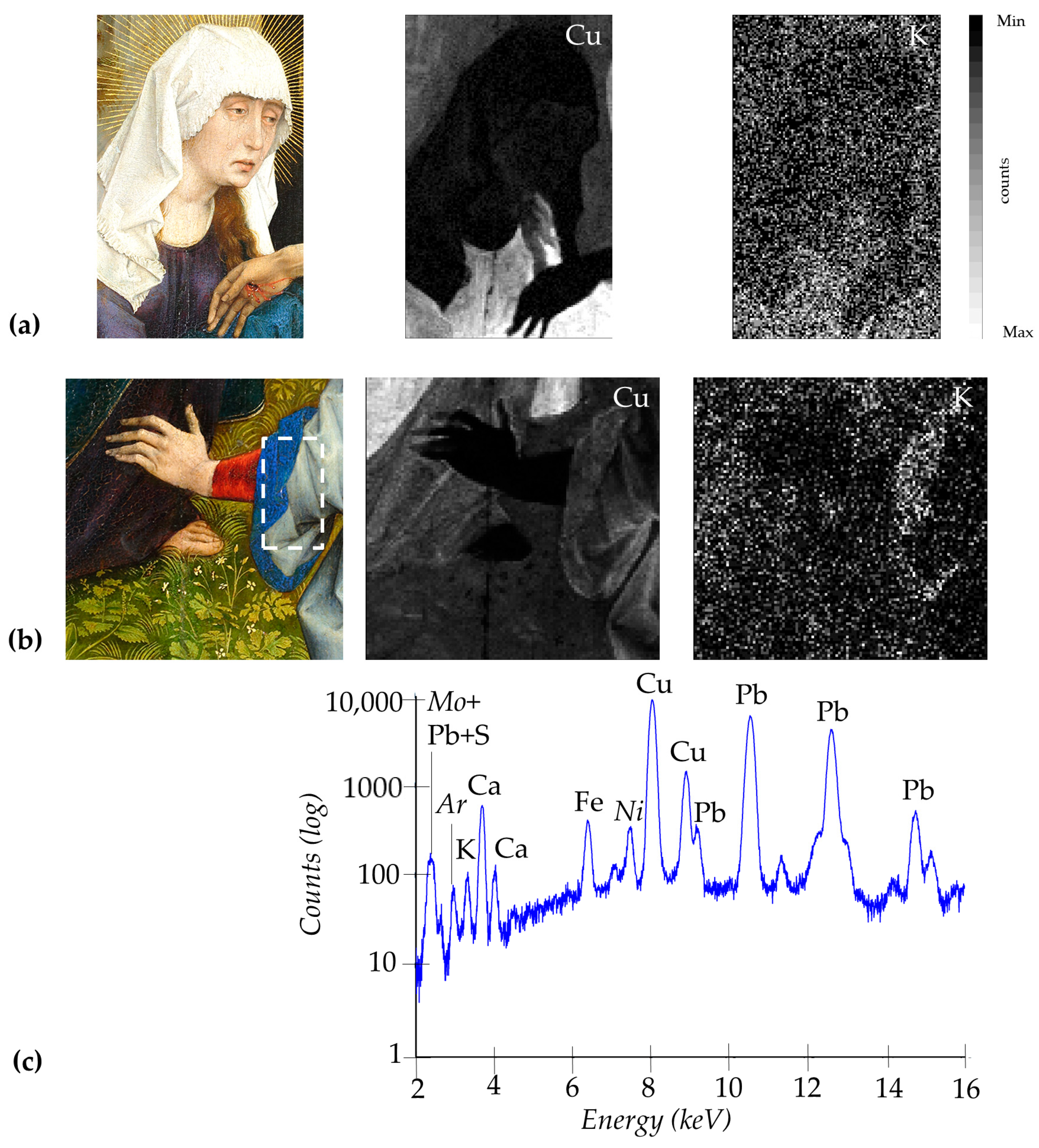
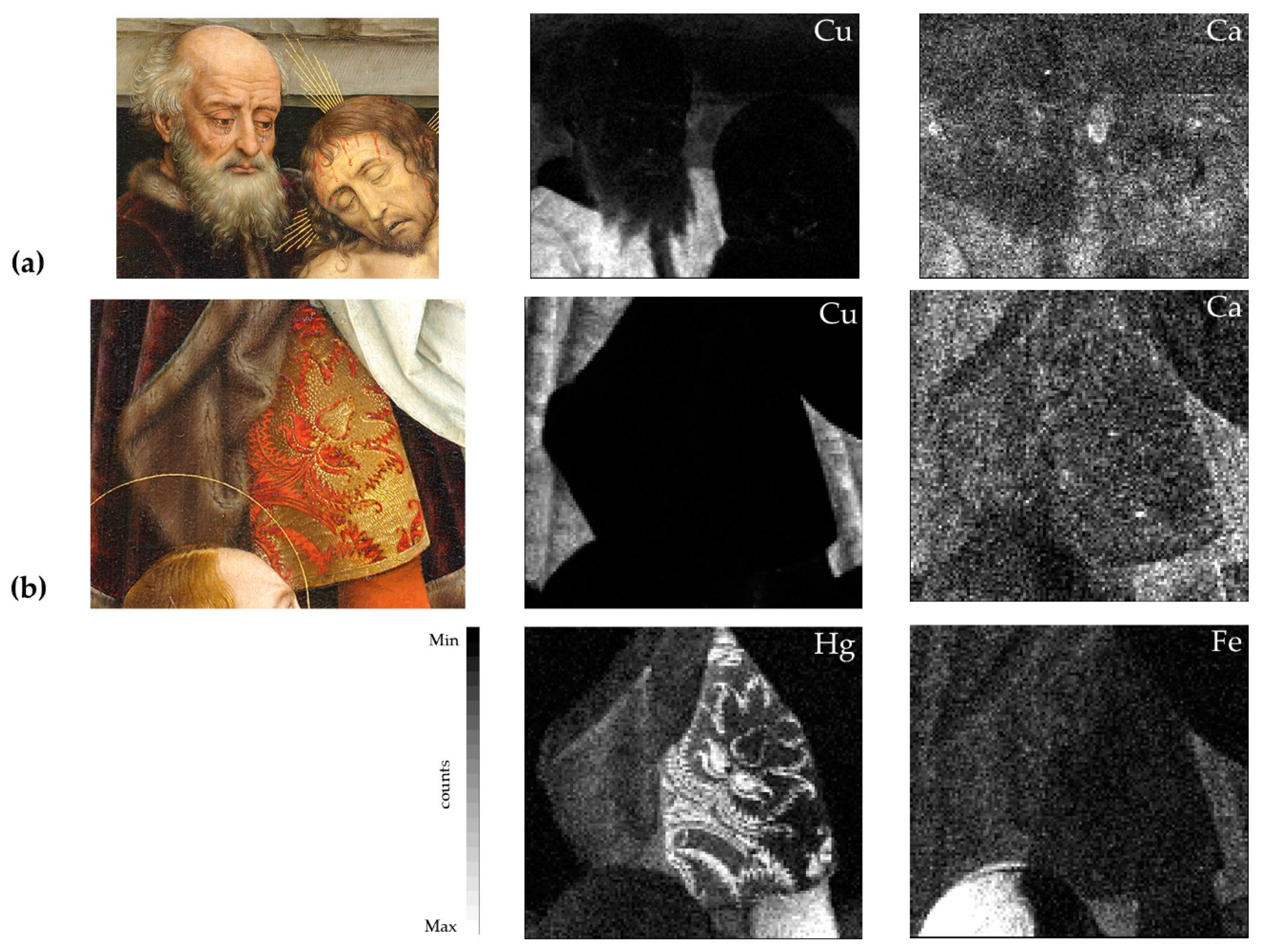
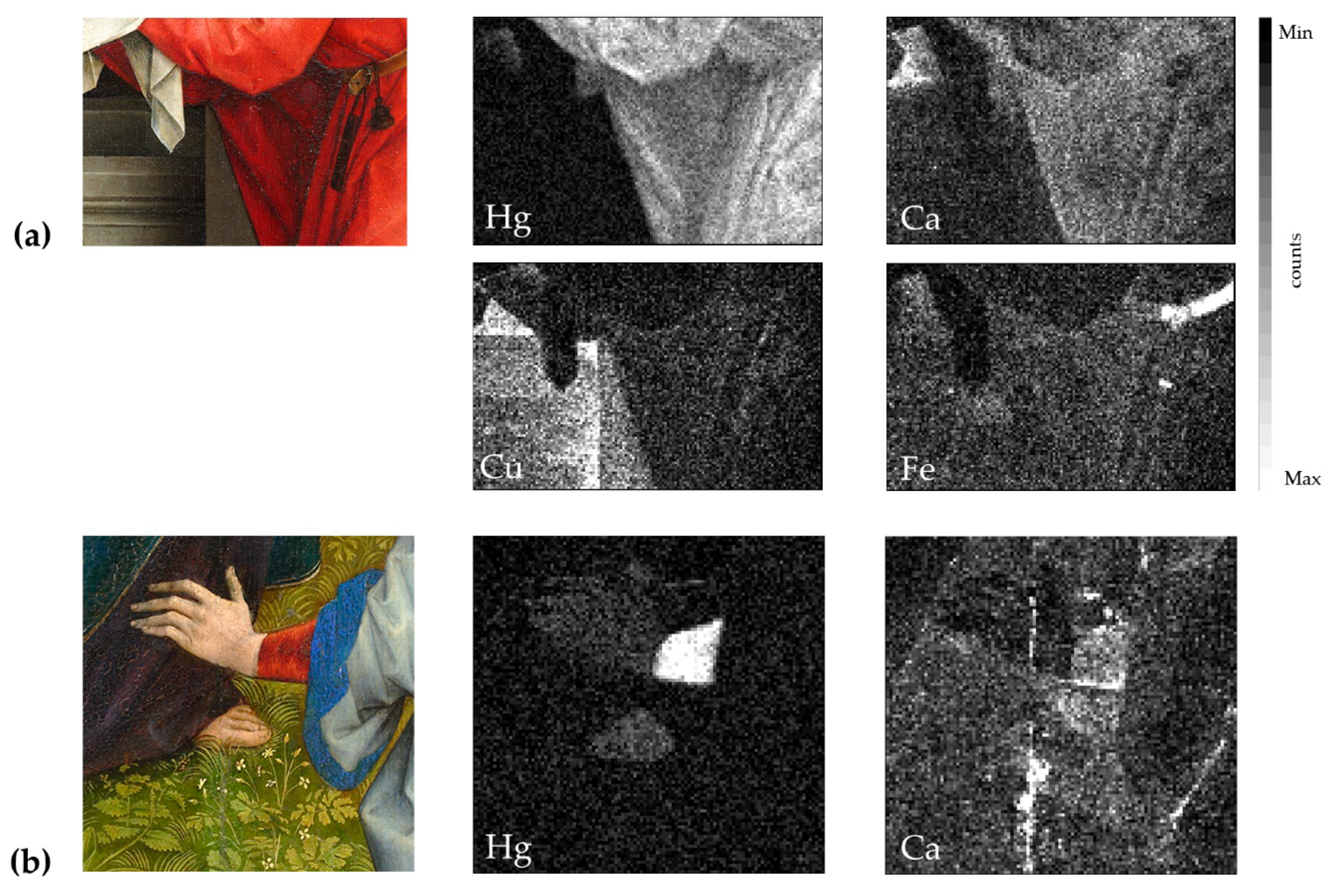
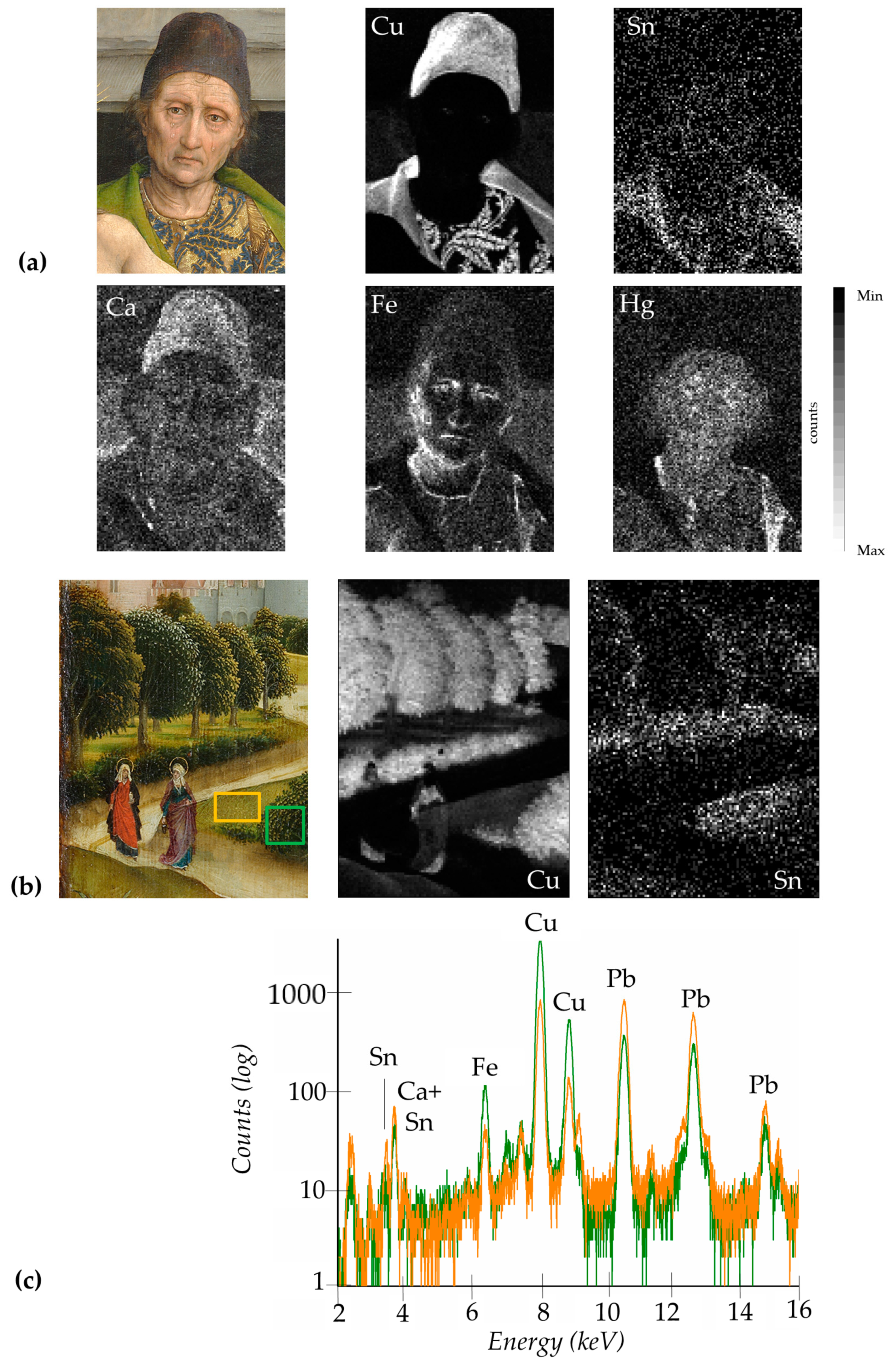
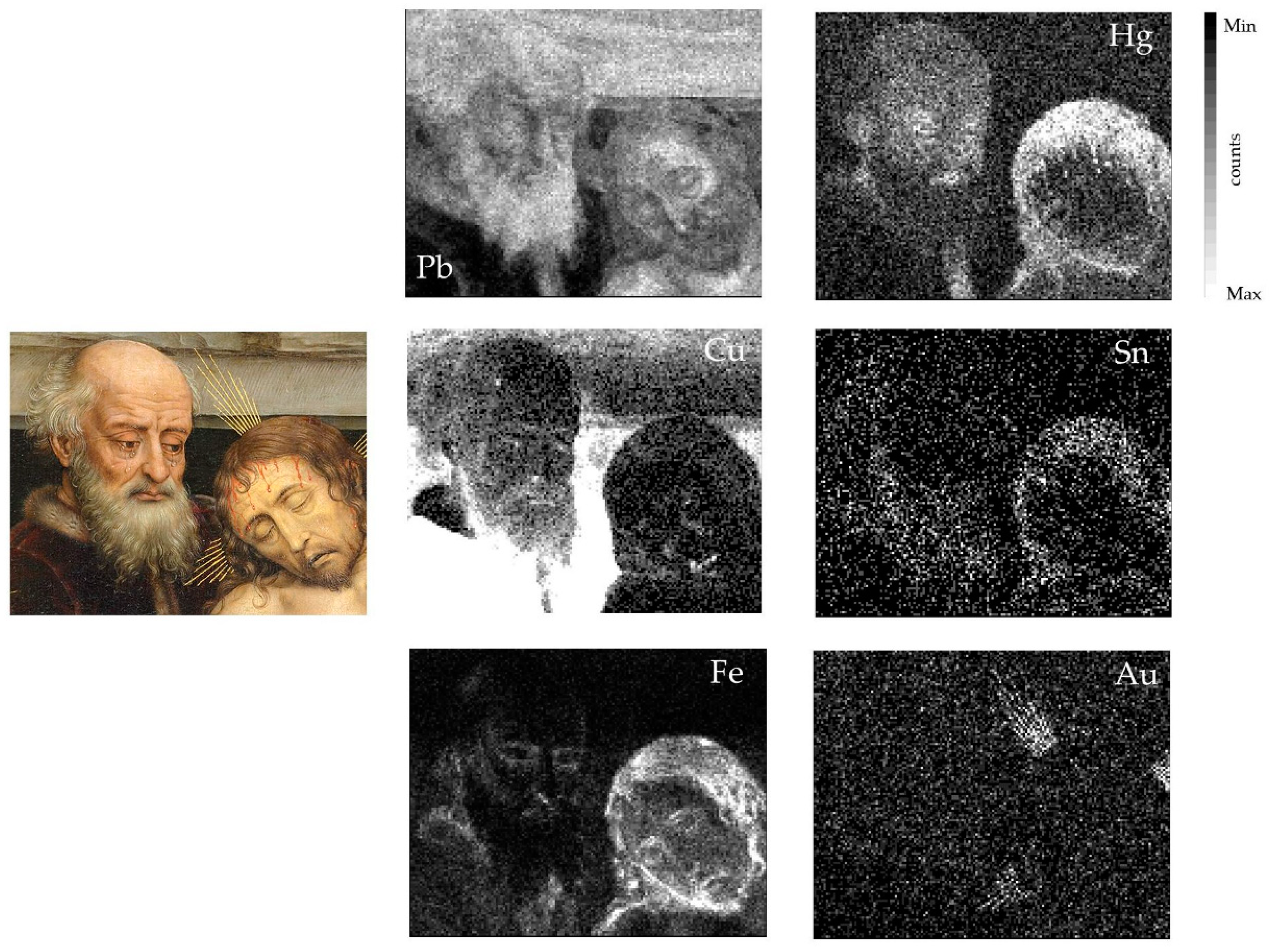
Publisher’s Note: MDPI stays neutral with regard to jurisdictional claims in published maps and institutional affiliations. |
© 2021 by the authors. Licensee MDPI, Basel, Switzerland. This article is an open access article distributed under the terms and conditions of the Creative Commons Attribution (CC BY) license (https://creativecommons.org/licenses/by/4.0/).
Share and Cite
Mazzinghi, A.; Ruberto, C.; Castelli, L.; Czelusniak, C.; Giuntini, L.; Mandò, P.A.; Taccetti, F. MA-XRF for the Characterisation of the Painting Materials and Technique of the Entombment of Christ by Rogier van der Weyden. Appl. Sci. 2021, 11, 6151. https://doi.org/10.3390/app11136151
Mazzinghi A, Ruberto C, Castelli L, Czelusniak C, Giuntini L, Mandò PA, Taccetti F. MA-XRF for the Characterisation of the Painting Materials and Technique of the Entombment of Christ by Rogier van der Weyden. Applied Sciences. 2021; 11(13):6151. https://doi.org/10.3390/app11136151
Chicago/Turabian StyleMazzinghi, Anna, Chiara Ruberto, Lisa Castelli, Caroline Czelusniak, Lorenzo Giuntini, Pier Andrea Mandò, and Francesco Taccetti. 2021. "MA-XRF for the Characterisation of the Painting Materials and Technique of the Entombment of Christ by Rogier van der Weyden" Applied Sciences 11, no. 13: 6151. https://doi.org/10.3390/app11136151
APA StyleMazzinghi, A., Ruberto, C., Castelli, L., Czelusniak, C., Giuntini, L., Mandò, P. A., & Taccetti, F. (2021). MA-XRF for the Characterisation of the Painting Materials and Technique of the Entombment of Christ by Rogier van der Weyden. Applied Sciences, 11(13), 6151. https://doi.org/10.3390/app11136151






